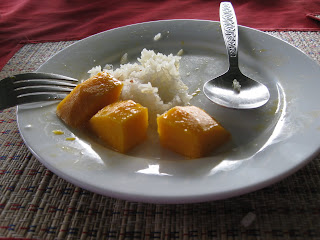As I walked outside, I noticed the chill. It had been weeks and weeks, since Sapa to be exact, since I had been able to walk outside without immediately sweating. Gross, maybe, but true. I'm only telling you this so that you can try to imagine my delight on being able to walk outside without sweating AND with my hair down. Sigh...it was bliss.

The scenery didn't hurt either.
So I wandered around the quiet capital city, turning corners at whim, switching from sidewalk to sidewalk depending on which side was sunniest. I gradually found my way to a restaurant that I'd read about in the guidebook, a place known for its spring rolls and pork brochettes (think pork kebabs).
I strolled up to a very busy storefront, with the "kitchen" out front, spread across two carts. There was a line of people shouting orders at the cooks working busily behind the glass displays of about eight different kinds of fresh spring rolls, piles of fresh herbs, plates of lettuces, and a completely full dining room inside.
I was a bit overwhelmed, and held back a bit, in order to watch and figure out the best approach. Apparently, my confusion and skepticism at breaking this restaurant's particular entrance code was quite recognizable, as a man to my right turned to me, smiled and asked a bit tentatively in French if I needed help.
Smiling gratefully, I explained that everything looked delicious, but I wasn't really sure what the procedure was, how to score a table or what to order. He introduced me to his lovely wife and daughter, then he and his wife recommended a few things to me, told me how much to order, and instructed me to snatch up a table as soon as I saw anyone making any kind of a motion to get up. The place was busy!
I gave him another grateful smile (I'm good at those), then squared my shoulders, ready to jump in as soon as I saw an opening at one of the tables.
Five minutes later, I was still squared up and waiting, and the helpful Laotian family were on their way out to share their food with family waiting at home. Looking back, the father saw me and came back to help. He asked the ladies if there were any tables free and to look after me to help me get the next available one. Then, giving me a smile, he headed off with his daughter looking suspiciously at me over his shoulder.

Two minutes later, I sat down to the spread you see above, along with a rather large Beer Lao, and utterly gorged myself on roll your own pork brochette spring rolls.

After I had thoroughly enjoyed and stuffed myself, I wandered around a bit more before I decided that the best way to cap off this lovely day was to find myself a little corner, grab a book and watch the world go by.
Which I did.
The following day I took a bus from the 1970s to Vang Vieng, the infamous land of drunken river tubing. I didn't have enough time to partake in the festivities, as I was heading the following day to Luang Prabang and arrived too late to be off the river by dark. Since I'd heard a horror story of tramping barefoot through the brush in the darkness from a traveler in Vietnam, I thought it was better to forgo the tubing.
Just so you know, the tubing is supposed to be a great time, with bars lining the river, along with mud beach volleyball courts, zip lines and rope swings. It just wasn't enough to convince me to miss out on Luang Prabang.
I did, however, take a rather spectacular walk at sunset, enjoy a few Friends reruns and have probably three mango shakes. Oh, that and some more fish laap and sticky rice. Hmmm...I think that I'm beginning to sound predictable.
Anyway, instead of a long post about my experiences in Vang Vieng, which, to be honest, weren't incredibly interesting, I thought I'd leave you with some pictures of a beautiful town with a deteriorating reputation for nothing more than booze and backpackers.






























